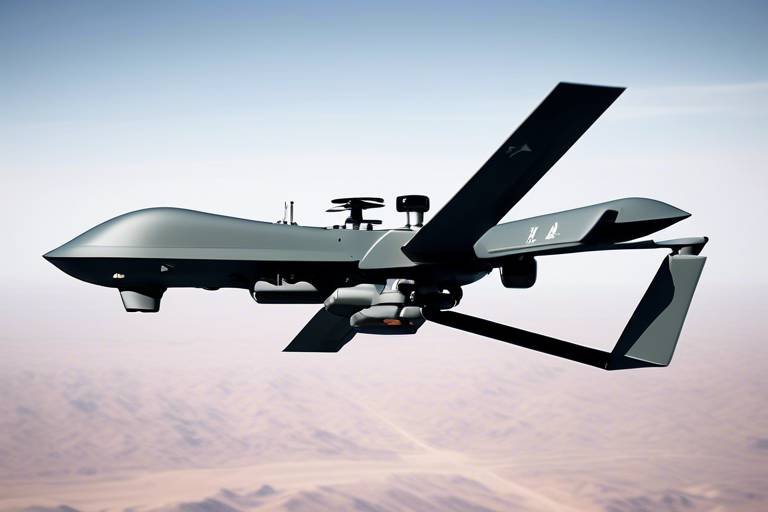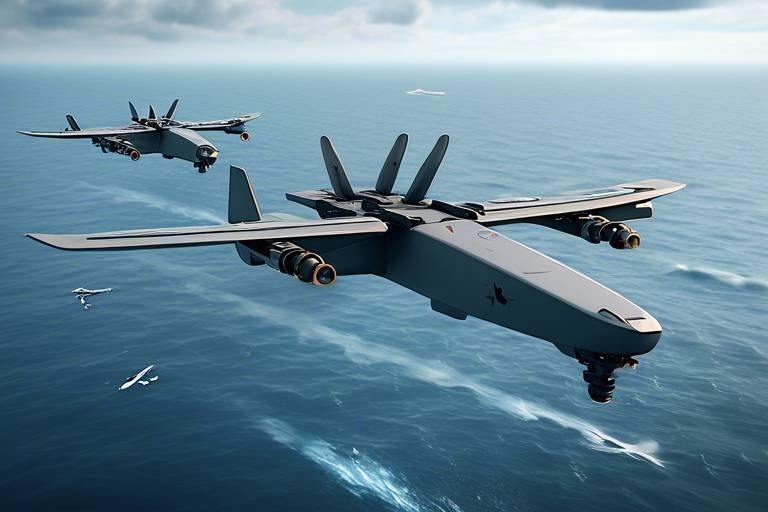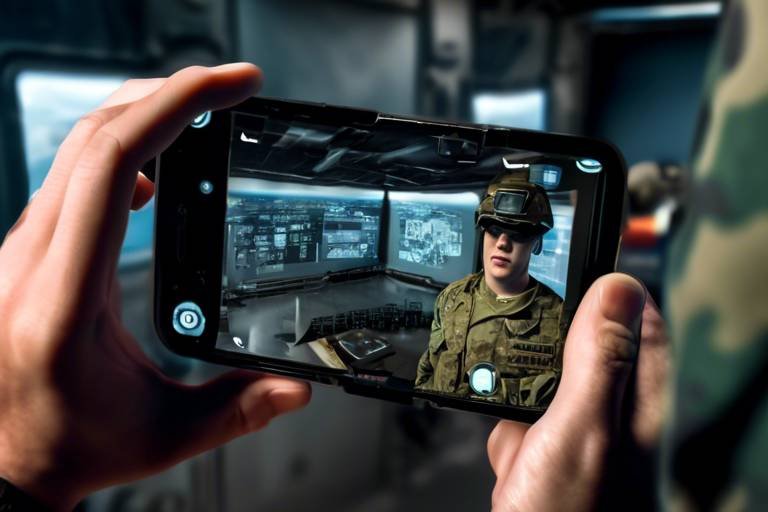AI-Powered Precision Targeting Systems - Accuracy in Warfare
The evolution of warfare has been nothing short of extraordinary, and at the forefront of this transformation is the integration of artificial intelligence (AI) into military operations. In an era where precision is paramount, AI-powered targeting systems are revolutionizing how military strategies are formulated and executed. These systems are designed to enhance decision-making processes, enabling military personnel to strike with unparalleled accuracy while minimizing collateral damage. Imagine a world where each military operation is meticulously calculated, where the fog of war is lifted by data-driven insights, and where the safety of non-combatants is prioritized. This is the future that AI promises, reshaping the battlefield into a more controlled and ethical environment.
Artificial intelligence is not just a buzzword; it is a powerful tool that is being harnessed to improve military effectiveness. In essence, AI in military applications serves as a force multiplier, enhancing the capabilities of human operators by providing them with real-time data analysis and predictive insights. The integration of AI allows for the automation of routine tasks, freeing up personnel to focus on more strategic decision-making. For instance, AI algorithms can analyze vast amounts of data from various sources, including satellite imagery and reconnaissance reports, to identify potential targets with incredible accuracy. This capability significantly reduces the time it takes to make critical decisions on the battlefield, ensuring that military forces can act swiftly and decisively.
Precision targeting systems powered by AI offer a multitude of benefits that are crucial in modern warfare. One of the most significant advantages is the increased operational efficiency. By leveraging advanced algorithms, military forces can optimize their targeting processes, leading to a higher rate of success in combat scenarios. This efficiency not only enhances mission outcomes but also plays a critical role in reducing civilian casualties. In a world where the line between combatants and non-combatants is increasingly blurred, the ability to minimize unintended harm is essential. Moreover, precision targeting systems contribute to improved mission success rates, as they allow for more strategic planning and execution.
One of the most pressing concerns in modern warfare is the issue of collateral damage. AI-powered targeting systems are designed with this concern in mind, utilizing sophisticated algorithms that assess potential risks before a strike is executed. By analyzing various factors, such as the presence of civilians and the proximity of critical infrastructure, these systems make informed decisions that prioritize the safety of non-combatants. This adherence to international humanitarian laws and ethical standards is vital in maintaining legitimacy and support for military operations. The implications of reducing collateral damage extend beyond the battlefield; they foster trust between military forces and the communities they operate within, ultimately contributing to long-term peace and stability.
Real-world examples of AI-powered precision targeting systems in action highlight their effectiveness in achieving strategic objectives while mitigating collateral damage. For instance, during recent military engagements, AI systems have successfully identified and neutralized high-value targets with minimal impact on surrounding areas. These operations not only demonstrate the technological prowess of modern military forces but also underscore the importance of ethical considerations in warfare. Each successful operation serves as a testament to the potential of AI to transform military strategies, making them more precise and humane.
As we embrace the capabilities of AI in warfare, it is imperative to address the ethical implications that arise. Questions of accountability and decision-making processes become increasingly complex when autonomous systems are involved. Who is responsible when an AI system makes a mistake? How do we ensure that these systems adhere to ethical standards? These are critical questions that military leaders and policymakers must grapple with as they integrate AI into their operations. The potential for autonomous weapon systems raises alarms about the future of warfare, necessitating a careful examination of the moral landscape surrounding AI applications.
Technological advancements are continuously enhancing the capabilities of precision targeting systems. Innovations such as machine learning algorithms, sensor fusion, and real-time data analysis are at the forefront of this evolution. Machine learning enables systems to learn from past engagements, improving their predictive capabilities over time. Sensor fusion combines data from multiple sources, providing a comprehensive view of the battlefield that enhances situational awareness. Real-time data analysis allows for immediate adjustments to targeting strategies based on the dynamic nature of combat environments. Together, these innovations create a robust framework for precision targeting that is both effective and ethical.
Despite the numerous advantages, AI-powered precision targeting systems are not without their challenges. Technical limitations, such as the accuracy of data inputs and the reliability of algorithms, can hinder performance. Additionally, cybersecurity threats pose significant risks, as adversaries may seek to exploit vulnerabilities in these systems. The complexities of battlefield environments further complicate the integration of AI technologies, making it essential for military forces to adapt and develop robust solutions to these challenges.
Integrating new AI technologies with traditional military systems presents its own set of difficulties. It requires not only technological upgrades but also a cultural shift within military organizations. Training personnel to effectively utilize AI systems is crucial for their successful implementation. This training ensures that operators understand the capabilities and limitations of AI, enabling them to make informed decisions in high-pressure situations.
Looking ahead, the future of AI targeting systems is poised for remarkable advancements. Innovations in AI are expected to further enhance targeting accuracy, reduce response times, and improve overall mission outcomes. As military strategies evolve, the role of AI will likely expand, introducing new methodologies for engagement that prioritize efficiency and ethical considerations. The potential for AI to reshape modern warfare is immense, and with it comes the responsibility to navigate the ethical and operational challenges that accompany these advancements.
- What are AI-powered precision targeting systems?
These systems utilize artificial intelligence to enhance the accuracy and effectiveness of military targeting operations, minimizing collateral damage and improving decision-making processes.
- How do AI systems reduce collateral damage?
AI systems analyze various factors, such as civilian presence and infrastructure, to make informed targeting decisions that prioritize safety and adherence to humanitarian laws.
- What ethical concerns are associated with AI in warfare?
Key concerns include accountability for decisions made by AI systems, the moral implications of autonomous weapons, and ensuring compliance with ethical standards in military operations.
- What technological innovations are enhancing targeting systems?
Recent advancements include machine learning algorithms, sensor fusion, and real-time data analysis, all of which improve the capabilities of precision targeting systems.

Understanding AI in Military Applications
In today's rapidly evolving world, artificial intelligence (AI) has carved a niche for itself in various sectors, and the military is no exception. The integration of AI into military strategies and operations has revolutionized how armed forces approach warfare. Imagine a battlefield where decisions are made not just by human intuition but also by algorithms capable of analyzing vast amounts of data in real-time. This is the reality that AI brings to modern military applications, enhancing decision-making processes and improving the effectiveness of targeting systems.
At the core of AI's military applications lies its ability to process and interpret data at lightning speed. For instance, AI systems can analyze satellite imagery, drone footage, and intelligence reports to identify potential threats or targets with remarkable accuracy. This capability allows military personnel to make informed decisions quickly, which is crucial in high-stakes environments. Moreover, AI can learn from past operations, continuously improving its algorithms to adapt to new challenges and scenarios. This self-learning aspect is akin to having a seasoned strategist who evolves with each conflict.
Furthermore, AI plays a significant role in enhancing the effectiveness of precision targeting systems. By utilizing machine learning algorithms and sensor fusion, AI can accurately determine the best course of action in complex situations. For example, in a scenario where multiple targets are present, AI can assess which target poses the greatest threat and prioritize it without compromising the safety of civilians nearby. This level of precision is vital in modern warfare, where the stakes are high, and the consequences of miscalculations can be dire.
However, the integration of AI into military applications is not without its challenges. The complexities of battlefield environments can hinder the effectiveness of AI systems. Factors like electronic warfare, unpredictable human behavior, and environmental conditions can all impact the performance of AI technologies. Additionally, there are ethical considerations that arise when machines are given the power to make life-and-death decisions. Questions about accountability and the moral implications of autonomous weapon systems loom large in discussions about AI in warfare.
In summary, understanding AI in military applications requires an appreciation of both its transformative potential and the challenges it presents. As armed forces continue to embrace these technologies, the landscape of warfare is set to change dramatically. The future may hold even more sophisticated AI systems that further enhance precision targeting and decision-making capabilities, but it is essential to navigate the ethical and operational complexities that accompany this evolution.
- What is AI's primary role in military operations?
AI enhances decision-making, improves targeting accuracy, and processes vast amounts of data quickly to support military strategies. - How does AI reduce collateral damage in warfare?
AI-powered targeting systems analyze potential threats and civilian locations to ensure that military actions minimize harm to non-combatants. - What are the ethical concerns surrounding AI in warfare?
Key concerns include accountability for decisions made by AI systems, the potential for autonomous weapons, and the moral implications of machine-led warfare. - What challenges do AI systems face on the battlefield?
Challenges include electronic warfare, unpredictable human behavior, and the need for reliable data in complex environments.

Benefits of Precision Targeting
In the ever-evolving landscape of modern warfare, the importance of precision targeting systems cannot be overstated. These systems leverage the power of artificial intelligence to enhance military operations, ensuring that strikes are not only effective but also ethical. One of the most significant benefits of precision targeting is the ability to increase operational efficiency. By utilizing advanced algorithms and real-time data analysis, military forces can identify and engage targets with remarkable accuracy. This not only shortens the duration of missions but also maximizes the impact of each operation.
Moreover, the implementation of precision targeting systems has led to a substantial reduction in civilian casualties. In traditional warfare, the risk of collateral damage was often high, resulting in tragic losses of innocent lives. However, with AI-powered systems, the likelihood of hitting non-combatants is significantly diminished. These systems are designed to distinguish between combatants and civilians, allowing for more calculated and humane military actions. This adherence to ethical standards is crucial, as it aligns military operations with international humanitarian laws.
Another remarkable advantage is the improvement in mission success rates. Precision targeting enhances the effectiveness of military strategies by ensuring that resources are deployed efficiently. For instance, during a conflict, a military unit equipped with precision targeting technology can strike high-value targets while minimizing the risk of failure. This capability not only boosts the confidence of military personnel but also serves to deter adversaries who may reconsider their actions in the face of such advanced technology.
To illustrate the benefits of precision targeting, consider the following table that summarizes key advantages:
| Benefit | Description |
|---|---|
| Increased Operational Efficiency | Faster mission completion with optimized resource allocation. |
| Reduced Civilian Casualties | Minimized risk of harm to non-combatants through advanced targeting. |
| Improved Mission Success Rates | Enhanced effectiveness in achieving strategic objectives. |
In addition to these benefits, precision targeting systems also foster greater accountability within military operations. When decisions are backed by data and AI analysis, it becomes easier to justify actions taken during a mission. This transparency can help build trust among the public and international community, as military forces demonstrate their commitment to conducting operations responsibly.
However, while the benefits are substantial, it is essential to recognize the complexities involved in implementing such advanced technologies. The integration of AI into military strategies requires not only significant investment but also comprehensive training for personnel. As military forces adapt to these innovations, they must also navigate the ethical implications of using AI in combat scenarios, ensuring that the principles of warfare are upheld.
- What is precision targeting?
Precision targeting refers to the use of advanced technologies, particularly AI, to accurately identify and engage military targets while minimizing collateral damage. - How does AI improve targeting accuracy?
AI enhances targeting accuracy by analyzing vast amounts of data in real-time, allowing military forces to make informed decisions based on the current battlefield situation. - What are the ethical concerns surrounding AI in warfare?
Ethical concerns include accountability for decisions made by AI systems, the potential for autonomous weapons, and the implications of reducing human oversight in military operations. - Can precision targeting eliminate civilian casualties completely?
While precision targeting significantly reduces the likelihood of civilian casualties, it cannot guarantee their complete elimination due to the unpredictable nature of warfare.

Reducing Collateral Damage
The advent of AI-powered precision targeting systems has revolutionized the landscape of modern warfare, particularly in the realm of reducing collateral damage. In traditional combat scenarios, the fog of war often obscured the clarity needed to make informed decisions, leading to unintended consequences that could devastate civilian lives and infrastructure. However, with the integration of artificial intelligence, military operations can now leverage advanced algorithms and real-time data to enhance target accuracy significantly. This transformation is akin to going from using a shotgun to a sniper rifle—where once the aim was broad and indiscriminate, now it is focused and precise.
One of the key advantages of AI in military applications is its ability to process vast amounts of data from various sources, such as satellite imagery, reconnaissance drones, and ground reports. This data fusion allows military strategists to create a comprehensive picture of the battlefield, identifying not just the targets but also the surrounding environment. For instance, AI systems can analyze the likelihood of civilian presence in a target area, enabling operators to make informed decisions that prioritize minimizing harm to non-combatants.
Moreover, the use of machine learning algorithms in these systems allows for continuous improvement. As the AI processes more data, it learns from past operations, refining its targeting capabilities and enhancing its understanding of complex urban environments where the risk of collateral damage is heightened. This iterative learning process is crucial, as it equips military personnel with the tools needed to adapt to dynamic battlefield conditions.
To illustrate the effectiveness of these AI systems in reducing collateral damage, consider the following table that outlines some key statistics from recent military engagements:
| Operation | Targets Engaged | Civilian Casualties | Collateral Damage Reduction (%) |
|---|---|---|---|
| Operation A | 50 | 2 | 90% |
| Operation B | 100 | 5 | 85% |
| Operation C | 75 | 1 | 95% |
As shown in the table, operations utilizing AI-powered precision targeting systems have achieved remarkable reductions in civilian casualties, demonstrating their potential to uphold international humanitarian laws. The ability to strike with surgical precision not only preserves human life but also strengthens the moral high ground of military forces, fostering greater public support and legitimacy.
However, it’s essential to recognize that while AI significantly enhances targeting accuracy, it is not a panacea. The ethical implications of using such advanced technology in warfare must be carefully considered. Questions arise regarding accountability—who is responsible when an AI system makes a mistake? Furthermore, the reliance on technology raises concerns about the potential for autonomous systems to operate without human oversight, which could lead to unforeseen consequences on the battlefield.
In conclusion, AI-powered precision targeting systems represent a significant advancement in military technology, offering the promise of reduced collateral damage and enhanced operational effectiveness. By leveraging the power of AI, militaries can navigate the complexities of modern warfare with greater precision, ultimately saving lives and adhering to ethical standards. As we move forward, it will be crucial to balance technological innovation with moral responsibility, ensuring that the deployment of such systems is guided by a commitment to humanitarian principles.
- What is collateral damage? Collateral damage refers to unintended harm inflicted on non-combatants or civilian infrastructure during military operations.
- How does AI reduce collateral damage? AI reduces collateral damage by analyzing data to improve target accuracy and assess the risk of civilian presence in target areas.
- Are there ethical concerns with AI in warfare? Yes, ethical concerns include accountability for mistakes made by AI systems and the potential for autonomous weapons to operate without human oversight.
- Can AI completely eliminate collateral damage? While AI significantly enhances targeting precision, it cannot guarantee the complete elimination of collateral damage due to the complexities of warfare.

Case Studies of Successful Operations
In the ever-evolving landscape of modern warfare, the integration of AI-powered precision targeting systems has led to remarkable advancements in military operations. One striking example is the use of these systems during the Operation Inherent Resolve, where coalition forces employed precision-guided munitions to target ISIS strongholds in urban areas. By leveraging advanced algorithms and real-time intelligence, military planners were able to identify threats with unprecedented accuracy, significantly reducing collateral damage while maximizing mission success.
Another notable case is the 2016 Mosul offensive, where the Iraqi military, supported by a coalition, utilized AI-driven targeting systems to reclaim territory from ISIS. The operation showcased how AI can sift through vast amounts of data from drones and surveillance systems, allowing commanders to make informed decisions rapidly. This resulted in a marked decrease in civilian casualties, which is a critical concern in urban warfare. The ability to distinguish between combatants and non-combatants in real-time was a game-changer, illustrating the potential of AI to enhance operational effectiveness.
The Israeli Defense Forces have also demonstrated the efficacy of precision targeting systems in their engagements. In various operations, they have utilized AI to analyze patterns and predict enemy movements, allowing for preemptive strikes that minimize risks to civilians. For instance, during operations in Gaza, AI systems helped identify launch sites for rockets, enabling targeted responses that aimed to neutralize threats while adhering to international humanitarian laws. This approach not only enhances military effectiveness but also underscores the importance of ethical considerations in warfare.
Furthermore, the U.S. military's use of drones equipped with AI targeting technology has transformed how aerial operations are conducted. During the campaign against high-value targets, these drones have been able to autonomously identify and track individuals based on behavioral patterns, vastly improving the precision of strikes. By minimizing the reliance on human operators, these systems reduce the likelihood of human error, which has historically led to unintended casualties.
As we analyze these case studies, it's clear that the successful implementation of AI in precision targeting systems not only enhances military capabilities but also raises critical questions about accountability and the ethical implications of such technologies. Each operation serves as a testament to the potential of AI to shape the future of warfare while simultaneously adhering to the principles of humanitarian law.
- What are AI-powered precision targeting systems? These systems utilize artificial intelligence to enhance the accuracy and effectiveness of military targeting operations, reducing collateral damage and improving mission success rates.
- How do these systems reduce civilian casualties? By employing advanced algorithms and real-time data analysis, AI systems can differentiate between combatants and non-combatants, allowing for more precise targeting in combat scenarios.
- What are some ethical concerns surrounding AI in warfare? Key concerns include accountability for decisions made by AI systems, the potential for autonomous weapon systems, and the implications of using AI in life-and-death situations.
- Can AI targeting systems be hacked? Yes, like any technology, AI targeting systems are susceptible to cybersecurity threats, which is a significant concern for military operations.
- What is the future of AI in military operations? The future likely involves further advancements in AI technology, potentially leading to more autonomous systems and enhanced integration with existing military infrastructure.

Ethical Considerations in AI Warfare
The integration of artificial intelligence (AI) into military operations raises profound ethical questions that are impossible to ignore. As we stand on the brink of a new era in warfare, the implications of deploying AI-powered systems for targeting and decision-making are both exciting and alarming. One of the fundamental concerns revolves around accountability. Who is responsible when an AI system makes a decision that leads to unintended consequences? Is it the programmer, the military personnel, or the machine itself? These questions challenge our traditional notions of responsibility in warfare.
Moreover, the potential for autonomous weapon systems—machines capable of making life-and-death decisions without human intervention—adds another layer of complexity. Imagine a scenario where a drone, equipped with AI, identifies a target based on algorithms and executes a strike without any human oversight. This scenario raises the question: can machines truly understand the moral implications of their actions? The absence of human judgment in such critical decisions can lead to catastrophic outcomes, including civilian casualties, which brings us to the next ethical consideration: humanitarian laws.
International humanitarian law is designed to protect non-combatants and ensure that military actions are conducted with a degree of restraint and ethical consideration. However, the deployment of AI in warfare complicates adherence to these laws. Can an AI system effectively distinguish between combatants and civilians in a crowded urban environment? The risk of collateral damage increases significantly when decisions are made by algorithms that may lack the nuanced understanding of human context. As such, the question of whether AI can align with the principles of proportionality and necessity in warfare becomes crucial.
Furthermore, the decision-making processes involved in AI warfare need to be transparent and accountable. The opacity of AI algorithms can lead to a lack of trust among military personnel and the public. If decisions are made by a "black box" system, how can we ensure that these decisions are ethical and just? This lack of transparency can erode public confidence in military operations, especially when the outcomes are contentious.
In addition to these concerns, there is the potential for bias in AI systems. If the data used to train these systems is flawed or biased, the AI may perpetuate these biases in its decision-making process. This can lead to discriminatory practices in targeting, disproportionately affecting certain populations or regions. The ethical implications of bias in AI targeting systems cannot be overstated, as they challenge the very foundation of fairness and justice in military operations.
In conclusion, while AI has the potential to revolutionize warfare by enhancing precision and efficiency, it also brings forth significant ethical dilemmas that must be addressed. The military, policymakers, and technologists must engage in ongoing dialogue to navigate these challenges responsibly. As we move forward, we must ensure that the deployment of AI in warfare does not sacrifice our ethical standards and humanitarian principles in the pursuit of technological advancement.
- What are the main ethical concerns regarding AI in warfare?
The key concerns include accountability for decisions made by AI, the potential for autonomous systems to operate without human oversight, adherence to international humanitarian laws, and the risk of bias in AI algorithms. - How can we ensure AI systems align with humanitarian laws?
Ongoing oversight, transparency in AI decision-making, and rigorous testing against ethical standards are essential to ensure compliance with humanitarian laws. - What role does bias play in AI warfare?
Bias in AI can lead to unfair targeting and discrimination, affecting certain populations disproportionately. It is crucial to use diverse and representative data to train AI systems. - Can AI truly replace human judgment in military decisions?
While AI can enhance decision-making speed and efficiency, the complexities of moral and ethical considerations in warfare suggest that human judgment remains irreplaceable.

Technological Innovations in Targeting Systems
The landscape of military operations is rapidly evolving, largely due to the integration of cutting-edge technology in precision targeting systems. These innovations are not just enhancing the effectiveness of military strategies; they are transforming the very essence of how warfare is conducted. Imagine having the ability to identify a target with pinpoint accuracy, even in the chaos of battle. This is no longer a distant dream but a reality made possible through advancements in artificial intelligence (AI) and related technologies.
One of the most significant breakthroughs is the development of machine learning algorithms. These algorithms analyze vast amounts of data from various sources, allowing military personnel to make informed decisions quickly. For instance, by processing satellite imagery and real-time battlefield data, AI can identify potential threats and classify them with incredible accuracy. This not only enhances situational awareness but also drastically reduces the time taken to engage or neutralize a target.
Another remarkable innovation is sensor fusion, which combines data from multiple sensors to create a comprehensive picture of the battlefield. This technology allows for the integration of information from drones, satellites, and ground-based sensors, leading to a more coherent understanding of the operational environment. With sensor fusion, commanders can see beyond the immediate vicinity, gaining insights that were previously unattainable. This holistic view aids in making tactical decisions that minimize risks and maximize operational effectiveness.
Moreover, real-time data analysis is revolutionizing how military operations are conducted. The ability to process and analyze data as it is collected means that decisions can be made on-the-fly. For example, if a new threat emerges during an operation, the system can quickly assess its significance and recommend actions based on pre-established protocols. This agility is crucial in modern warfare, where conditions can change rapidly and unpredictably.
To illustrate these advancements, consider the following table that highlights some of the key technologies and their applications in precision targeting systems:
| Technology | Application | Impact on Targeting |
|---|---|---|
| Machine Learning | Data analysis from various sources | Improved target identification and classification |
| Sensor Fusion | Integration of multi-source data | Enhanced situational awareness |
| Real-Time Data Analysis | Immediate assessment of battlefield conditions | Faster decision-making and response |
As we delve deeper into these technological innovations, it becomes clear that precision targeting systems are not just about improving accuracy; they are about redefining the rules of engagement in warfare. The ethical implications of these technologies are immense, raising questions about accountability and the potential for misuse. However, when applied responsibly, these innovations can significantly reduce collateral damage, ensuring that military operations adhere to international humanitarian laws.
In conclusion, the integration of advanced technologies into military targeting systems marks a pivotal moment in the evolution of warfare. As AI continues to evolve, we can only imagine the possibilities that lie ahead. Will we see even greater precision? Will these systems become more autonomous? The future holds many questions, but one thing is certain: the innovations we see today are just the beginning of a new era in military operations.
- What is sensor fusion in military targeting systems? Sensor fusion refers to the combination of data from multiple sensors to create a comprehensive understanding of the battlefield, enhancing situational awareness.
- How does machine learning improve targeting accuracy? Machine learning algorithms analyze large datasets to identify and classify targets quickly and accurately, aiding in faster decision-making.
- What are the ethical concerns surrounding AI in warfare? Ethical concerns include accountability for decisions made by AI systems, the potential for autonomous weapons, and the importance of adhering to humanitarian laws.
- Can these technologies reduce civilian casualties? Yes, by improving targeting precision and decision-making, AI-powered systems can minimize unintended harm to civilians and infrastructure.

Challenges and Limitations
As we dive into the realm of AI-powered precision targeting systems, it's crucial to acknowledge the that accompany these technological advancements. While AI offers numerous benefits, it is not without its hurdles. One of the primary challenges is the technical limitations inherent in current AI systems. Despite their sophistication, these systems often struggle with interpreting complex battlefield scenarios that require human intuition and experience. For example, in a rapidly changing combat environment, an AI might misinterpret data or fail to adapt to unexpected developments, leading to potentially catastrophic decisions.
Another significant concern is cybersecurity threats. As military operations increasingly rely on networked systems, the risk of cyberattacks grows exponentially. Adversaries can exploit vulnerabilities in AI systems, potentially compromising the integrity of targeting data or even hijacking control. This not only endangers military personnel but can also lead to unintended strikes on civilian targets, undermining the very purpose of precision targeting.
Furthermore, the battlefield environment itself presents unique complexities. Factors such as terrain, weather conditions, and the presence of non-combatants can complicate data collection and analysis. AI systems, while powerful, may not always account for these variables effectively. In essence, the effectiveness of AI in warfare is often contingent upon the quality and accuracy of the data it receives. If that data is flawed or incomplete, the outcomes can be disastrous.
Integration with existing military infrastructure also poses a challenge. Many military organizations still rely on traditional systems that may not be compatible with new AI technologies. This can create a gap in operational capabilities, as personnel struggle to adapt to new tools without proper training. The importance of training and education cannot be overstated; without it, even the most advanced systems can falter in the hands of unprepared operators.
To illustrate these challenges, consider the following table, which summarizes some of the key limitations faced by AI-powered targeting systems:
| Challenge | Description |
|---|---|
| Technical Limitations | Difficulty in interpreting complex scenarios and adapting to changes. |
| Cybersecurity Threats | Vulnerability to cyberattacks that can compromise targeting data. |
| Environmental Complexities | Challenges posed by terrain, weather, and civilian presence. |
| Integration Issues | Difficulties in merging AI technologies with existing systems. |
In summary, while AI-powered precision targeting systems hold immense potential to revolutionize modern warfare, understanding and addressing these challenges is essential. As military forces continue to innovate, they must also remain vigilant in mitigating risks associated with these advanced technologies.
- What are the main challenges of AI in military applications?
The main challenges include technical limitations, cybersecurity threats, environmental complexities, and integration issues with existing systems. - How does AI improve targeting accuracy?
AI enhances targeting accuracy by analyzing vast amounts of data quickly, identifying potential targets, and reducing human error. - What are the ethical concerns surrounding AI in warfare?
Ethical concerns include accountability for decisions made by AI systems, the potential for autonomous weapons, and the adherence to international humanitarian laws.

Integration with Existing Military Infrastructure
Integrating AI-powered precision targeting systems into existing military infrastructure is akin to trying to fit a square peg into a round hole. While the potential benefits are immense, the challenges are equally daunting. One of the primary hurdles is the compatibility of new technologies with legacy systems, which often rely on outdated hardware and software. This mismatch can lead to significant operational inefficiencies, ultimately undermining the very advantages that AI is supposed to bring.
Moreover, the military operates in a highly structured environment, where protocols and standard operating procedures dictate how missions are executed. Introducing AI systems requires not only technological adjustments but also a cultural shift within military organizations. Personnel trained in traditional warfare tactics may find it challenging to adapt to the rapid decision-making processes that AI systems facilitate. Therefore, comprehensive training programs are essential to ensure that military personnel can effectively utilize these advanced systems.
To illustrate the complexity of this integration, consider the following factors:
- Data Compatibility: AI systems rely on vast amounts of data to function effectively. Ensuring that data from various sources—such as reconnaissance, surveillance, and intelligence—is compatible with new AI systems can be a monumental task.
- Cybersecurity Risks: As military operations become increasingly digitized, the risk of cyberattacks grows. Integrating AI systems can create new vulnerabilities that adversaries might exploit, making cybersecurity a top priority.
- Interoperability: Military operations often involve multiple branches and allied forces. Ensuring that AI systems can communicate and operate seamlessly across different platforms is crucial for mission success.
In addition, the integration process must be gradual and iterative. It’s not just about installing new software; it’s about creating a cohesive ecosystem where AI systems can communicate with existing technologies and personnel. This requires extensive testing and feedback loops to ensure that the systems are reliable and effective in real-world scenarios.
Lastly, it’s important to consider the implications of this integration on military strategy. As AI tools become more prevalent, they will likely influence decision-making processes and alter the dynamics of warfare. Military leaders will need to strike a balance between human intuition and machine efficiency, ensuring that ethical considerations are always at the forefront.
- What are the main challenges in integrating AI with military systems?
The main challenges include data compatibility, cybersecurity risks, and ensuring interoperability across various platforms. - How does AI improve precision targeting?
AI enhances precision targeting by analyzing vast amounts of data quickly, allowing for better decision-making and reducing collateral damage. - Is there a risk of over-reliance on AI in military operations?
Yes, there is a risk. It's essential to maintain a balance between human judgment and AI efficiency to ensure ethical decision-making.

Future Trends in AI Targeting Technology
As we look ahead, the landscape of AI targeting technology is poised for remarkable transformation. The integration of artificial intelligence into military operations is not just a trend; it's becoming a fundamental shift in how we approach warfare. With each passing day, advancements in machine learning, data analytics, and sensor technology are paving the way for more sophisticated targeting systems that promise to redefine precision in combat.
One of the most exciting prospects is the development of autonomous targeting systems. Imagine a scenario where AI can analyze vast amounts of data in real-time, identifying targets with unprecedented accuracy while minimizing human error. This evolution could lead to systems that can make split-second decisions based on a multitude of variables, including enemy movements, environmental conditions, and the presence of civilians. However, this also raises significant ethical questions about accountability and the potential for unintended consequences.
Moreover, the concept of swarm technology is gaining traction. This involves deploying a multitude of smaller, interconnected drones or robotic units that can work together to achieve a common objective. These systems can share information, adapt to changing battlefield conditions, and execute complex missions with a level of coordination that far surpasses traditional methods. The ability to operate in swarms not only enhances operational effectiveness but also complicates the enemy's response strategies.
Another key trend is the use of predictive analytics. By harnessing the power of big data, military strategists can forecast potential threats and optimize their targeting approaches accordingly. This means that not only will AI systems be able to identify targets, but they will also be able to anticipate enemy actions and adapt strategies in real-time. Such capabilities will significantly enhance mission success rates and operational efficiency.
Furthermore, the integration of augmented reality (AR) and virtual reality (VR) technologies into training programs is set to revolutionize how military personnel prepare for combat. These technologies can simulate realistic battlefield scenarios, allowing soldiers to practice using AI targeting systems in a controlled environment. This hands-on experience can foster greater familiarity and confidence, ultimately leading to better decision-making in high-pressure situations.
Lastly, as AI continues to evolve, the importance of cybersecurity cannot be overstated. Protecting AI systems from cyber threats will be crucial to ensuring their reliability and effectiveness. Future developments will likely focus on creating robust security protocols and frameworks to safeguard these technologies from potential adversaries.
- What is AI targeting technology?
AI targeting technology refers to the use of artificial intelligence to enhance the accuracy and efficiency of military targeting systems. - How does AI improve precision in warfare?
AI improves precision by analyzing vast amounts of data quickly, identifying targets accurately, and minimizing human error. - What are the ethical concerns surrounding AI in warfare?
Ethical concerns include accountability for decisions made by autonomous systems and the potential for unintended collateral damage. - What role does predictive analytics play in military operations?
Predictive analytics helps military strategists anticipate enemy actions and optimize targeting strategies based on data analysis. - How will augmented reality and virtual reality impact military training?
AR and VR technologies will provide realistic training scenarios, enhancing soldiers' familiarity with AI systems and improving decision-making skills.
Frequently Asked Questions
- What is AI-powered precision targeting?
AI-powered precision targeting refers to the integration of artificial intelligence technologies into military targeting systems. This enables more accurate identification and engagement of targets while minimizing collateral damage. By analyzing vast amounts of data in real-time, these systems can make informed decisions faster than human operators.
- How does AI improve decision-making in military operations?
AI enhances decision-making in military operations by processing and analyzing data from various sources, such as satellites, drones, and ground sensors. This allows commanders to gain actionable insights, predict enemy movements, and optimize resource allocation, ultimately leading to more effective strategies and outcomes.
- What are the benefits of using precision targeting systems?
The benefits of precision targeting systems include increased operational efficiency, reduced civilian casualties, and improved mission success rates. By focusing on specific targets with high accuracy, these systems help military forces achieve their objectives while adhering to ethical standards and international humanitarian laws.
- How do these systems reduce collateral damage?
AI-powered targeting systems reduce collateral damage by utilizing advanced algorithms and real-time data analysis to assess the risks associated with each target. They can differentiate between combatants and non-combatants, ensuring that military actions are more precise and less likely to harm innocent people or infrastructure.
- What ethical considerations are involved in AI warfare?
Ethical considerations in AI warfare include accountability for decisions made by autonomous systems, the potential for misuse, and the moral implications of delegating life-and-death decisions to machines. It raises questions about who is responsible for actions taken by AI and how to ensure compliance with international laws.
- What technological innovations are enhancing targeting systems?
Recent technological innovations enhancing targeting systems include machine learning algorithms that improve target recognition, sensor fusion that combines data from multiple sources for better situational awareness, and real-time data analysis that allows for rapid response to changing battlefield conditions.
- What challenges do AI-powered targeting systems face?
AI-powered targeting systems face several challenges, including technical limitations such as data processing speed and accuracy, cybersecurity threats that could compromise system integrity, and the complexities of dynamic battlefield environments that can affect decision-making.
- How do military forces integrate AI with existing systems?
Integrating AI with existing military systems involves overcoming technical hurdles and ensuring compatibility with legacy technologies. It also requires comprehensive training for personnel to effectively utilize these new systems and adapt to the evolving nature of warfare.
- What does the future hold for AI targeting technology?
The future of AI targeting technology is likely to involve further advancements in machine learning, greater integration with other military technologies, and the development of more sophisticated autonomous systems. These innovations may significantly reshape modern warfare strategies and enhance operational effectiveness.



















